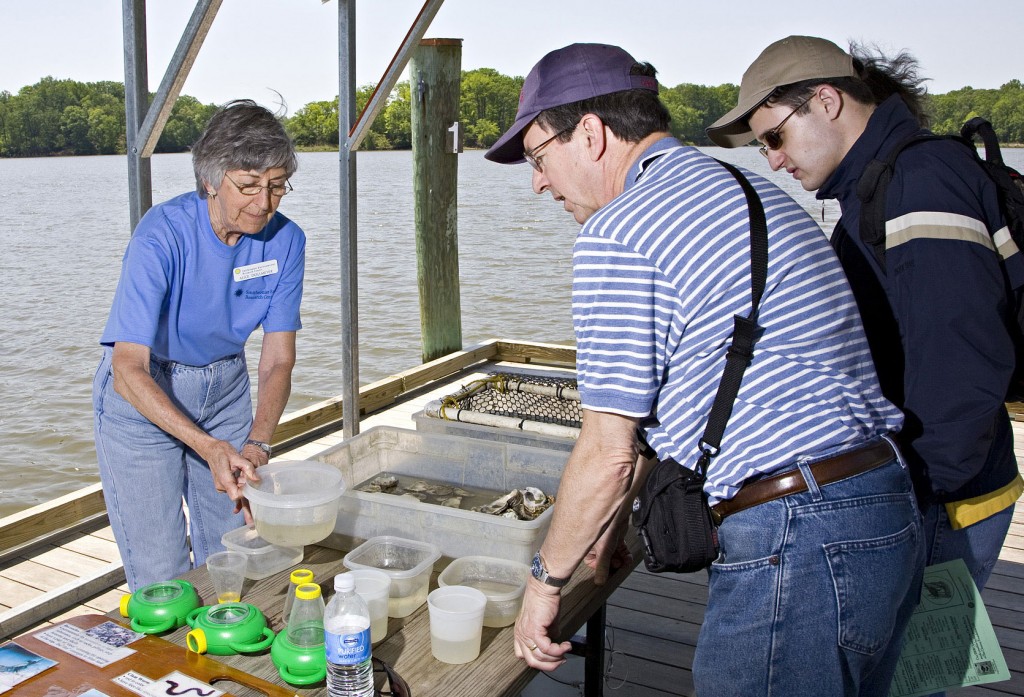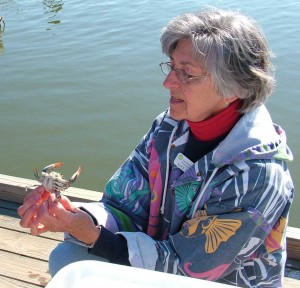by Kristen Minogue

Veteran volunteer Alice Dollmeyer (left) teaches visitors about oysters at SERC’s annual Open House. (Smithsonian)
After 23 years volunteering outside, Alice Dollmeyer has seen some filthy things. The dirtiest thing she remembers handling at SERC is an oyster basket pulled up from the docks. When she first began, the oyster trays didn’t hang but sat on the bottom of the Rhode River, and would often come up covered in black mud.
Since then Dollmeyer has done just about every education job a SERC volunteer can do. She has lead canoe trips, helped children pick up crabs and run all five stations of the Estuary Chesapeake program for visiting schools. She’s also shown up for every docent workday, a day of housekeeping which, as education specialist Jane Holly describes it, “You get your arms as dirty as possible cleaning up everything to get ready for the field season.”
“We all get out there and just dig in…I can’t think of anybody who minded being at workday,” Alice said.
Alice first wandered into SERC on a whim in 1991. Pulled in by the scenery and the small dark brown sign, she asked if she could walk around the property, and the staff told her there were just two trails open to the public. “Then they said, how would you like to volunteer out here? And I said, well, it’s a beautiful place. Sure I’d like that.”
She soon discovered volunteering at SERC took some grit. The campus was a very different place two decades ago. The Philip Reed Education Center on the docks, now the initial stop for visitors, had yet to open. In its place was an old house trailer with a linoleum floor and a limited septic system. One or two volunteer docents worked there almost entirely on their own, with the exception of a few personnel from the Maryland Department of Natural Resources, who occupied one-third of the trailer. The SERC education staff worked mostly out of the New Dominion building, an old dairy barn on the other side of campus.
Since SERC didn’t offer many public programs back then, most of Alice’s work involved leading school field trips. And the dark-brown entrance sign that had first caught her eye—tinier than the one today—was easy to overlook. “The first few years we were there, the school buses invariably missed that sign,” she said.
Things changed dramatically when the Reed Center opened in 1997 and they could work more closely with the education staff. Education director Mark Haddon and environmental education specialist Catie Drew came down first, and more followed.
“That seemed so great, because then if we had questions, we could fall back on someone then,” Alice said. “Up until that time, we were on our own.”
The general enthusiasm drew her to stay—of the staff, the other volunteers, and especially the students. “Any number of them have said, this is our best field trip of the year. It’s all hands-on. They’re not studying. They’re digging into oyster shells, they’re picking up crabs or trying to catch crabs, or out in chest waders in the water.”



So nice to read about Alice! She was one of our best volunteers! Just a slight correction – my title wasn’t “volunteer coordinator” but rather “environmental education specialist” – Catie Drew